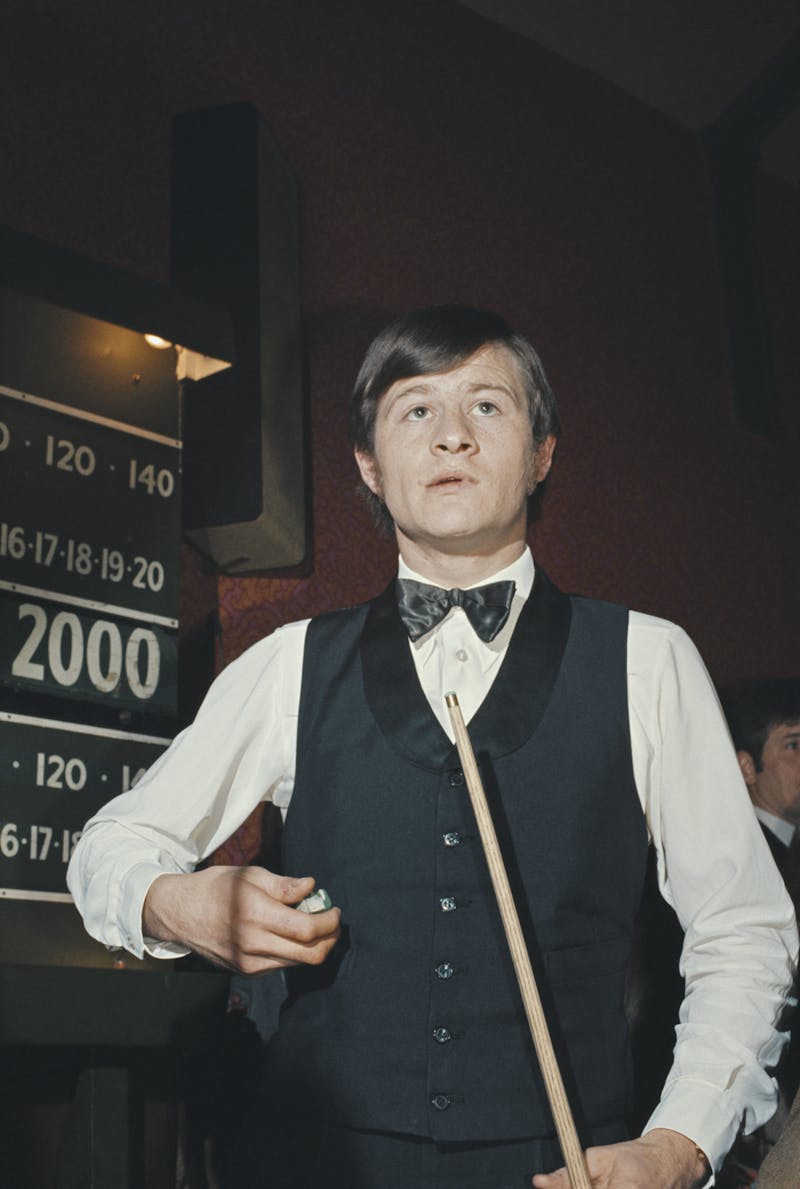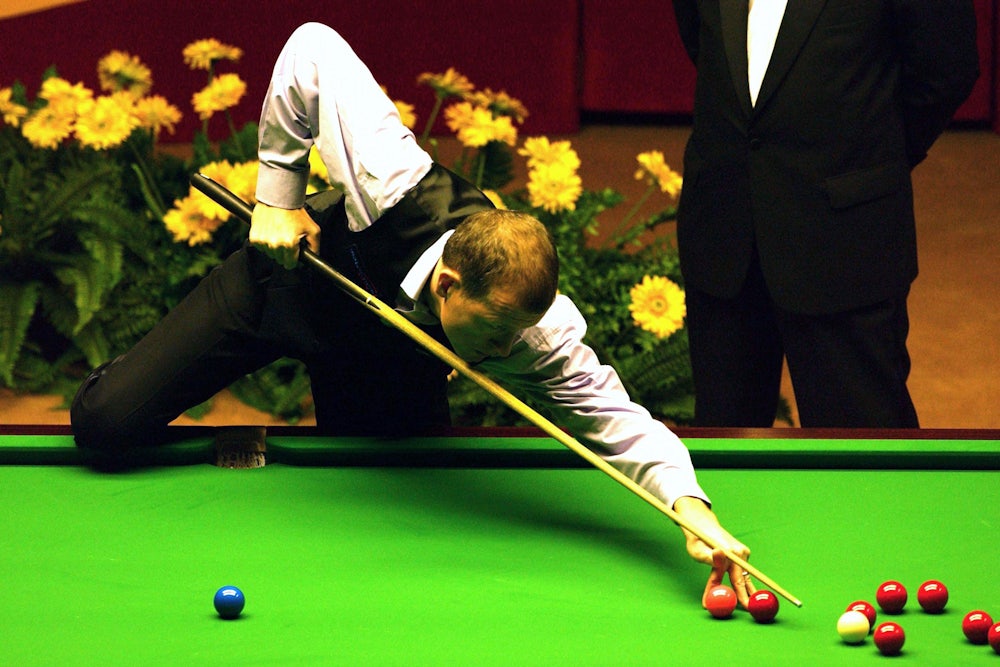Sports usually inject cathartic experiences into their supporters at regular intervals, and the current shortage can’t be good for fans’ health. As an interim measure, I recommend digging into the video archive of some less celebrated sport—the wallflowers to soccer or basketball’s prom queens, if you will—and following the rabbit hole to its end. My favorite stopgap-sport has been the unfashionable ballet of the green baize, also known as snooker.
As any history of snooker will tell you, its charm lies both in the game itself and its charismatic players, who are among sports’ best-dressed. What they can’t make you feel—what you have to learn for yourself—is how exquisite good snooker can be and the pitch of tension it can reach. It’s a game of pure skill, and so difficult to play well that a truly outstanding frame (snooker for “game”) will have you yelling at little colored balls rolling across your laptop screen.
Snooker is an offshoot of a parent sport, billiards, which grew out of the indoor version of a French croquet-style game. All billiards games involve hitting balls with cues, as you probably know from playing pool. That’s because, instead of whacking balls on grass with mallets, in this new rainy-day iteration players pushed them with sticks across green cloth (a.k.a. the “grass”). Billart is the French word for one of those sticks, hence the name of the grandfather of modern table sport.
An American pool table is small by comparison to a full competition snooker table, which is six-by-12 feet long, and has meaner, smaller pockets. Those dimensions make potting 22 balls in a specific order a spectacularly difficult proposition, both mathematically and psychologically. There are plenty of rules to learn, but the basic objective is this: first pot all 15 red balls, alternating with the six colored balls (which get returned to the table until the reds are all gone), then all the colored balls in a specific sequence. Miss a ball, and it’s your opponent’s turn. Matches consist of a specified odd number of frames, which can vary.
Next comes the nitty-gritty, the parts of the game that gave legendary player Ronnie O’Sullivan what he calls his “snooker depression.” Because you have to sink them in such precise sequence, at least two of the balls’ futures have to factor into the player’s calculations every time he shoots. It’s all very well sinking a red, but where is the white cue ball going to end up next? If it comes to rest trapped behind a row of reds and your next shot requires you to sink a color, for example, you’re screwed.
You’re always aiming to “build breaks,” meaning “pot” the balls in scoring sequence, but when a pot isn’t available, you can also play safety shots, with the explicit aim of limiting your opponent’s play, also known as snookering them. This kind of play can go on forever, until both players are quivering with exhaustion. The snookering in snooker is where the sport’s psychology comes into it, which splits fairly evenly into comedy, tragedy, and drama.

In the 1950s and ’60s, snooker wasn’t that big, especially since it didn’t suit black-and-white TV; you couldn’t see which ball was which. Then, when Sir David Attenborough took over BBC Two in the late 1960s, he decided to use snooker to test out the corporation’s new color technology. The result was Pot Black, a snooker show composed of knockout-style miniature games. It premiered three nights after the moon landing.
By this time, a certain young snooker player named Alex “Hurricane” Higgins had made himself into the sport’s first celebrity. A native of south Belfast, Higgins won his first titles in the late 1960s, turning pro in 1972 at the age of 22. Higgins (who died in 2010) was a dashing, troublesome alcoholic, whose flair for the game remains unmatched. He also got caught pissing in the flower arrangements at the Crucible, a famous snooker venue, and once drunkenly threatened to have Dennis Taylor, a fellow Northern Irish pro, shot dead.
Higgins is a tragic character, but he almost single-handedly drove the craze for snooker that peaked in 1980s Britain (you can see a fascinating snapshot of the sport on the rise in This England, a 1978 ITV Granada documentary). Ever since, big characters and silly nicknames have been bywords for the sport, which contains an odd mix of class signifiers: Pros play competitions in evening dress, and the referees wear white gloves, but public billiards halls are traditionally the domain of teenage boys and working men, not toffs. Jimmy “The Whirlwind” White, for example, came up by practicing in billiard halls when he should have been at school, meaning that he wasn’t so hot on reading at the start of his professional career. He still had to wear a tux.
That odd admixture of cultures is where snooker gets its old-school charm and humor. From the late 1970s through to the late ’80s, when the game got glossy and professional (and less fun), snooker was as much a comedy act as a game. When Jimmy White lost for the millionth time to Stephen Hendry, for example, his first words to the TV interviewer were, “He’s beginning to annoy me.” Snooker champ Ray Reardon used to flash his wonky teeth threateningly at opponents and was known as “Dracula.” Steve “Interesting” Davis revolutionized the sport in the 1980s by practicing snooker every night instead of going out and getting drunk, which nobody had thought of before. Best of all is Dennis Taylor, the adorable champion who chalked all his success up to his habit of wearing his glasses upside-down.
In the few golden years that snooker players were serious celebrities, somebody’s manager had the brilliant idea of putting together a pop song, called “Snooker Loopy,” which uses the click-clack of balls as a percussive motif. It’s catchy, if a little bit silly, and captures the knees-up cheer of pub sports nicely.
As Sam Knight put it in his 2015 profile of Ronnie O’Sullivan for The New Yorker, “Snooker’s civilized appearance belies its vicious and enervating nature.” It is time to begin our journey into the dark soul of snooker. Meet Ronnie “The Rocket” O’Sullivan, and the perfect frame he played at the 1997 World Championships in Sheffield.
Over the course of about five minutes, O’Sullivan, the greatest snooker player of all time, scored a maximum of 147 points by sinking every single ball on the table in the correct order without fail. You can see the white ball drawing triangles across the baize, according to his plans. During some shots, he barely waits for the balls to stop moving before he’s ready to strike again. Although there are no calculations shown on screen, the way that O’Sullivan moves around the table, the way his eyes dart and his limbs twitch, looks like a dance about mathematics—you can feel the old rules of snooker snap as he plays.
The first time you watch, it’s impressive. The second time, it’s breathtaking. But the hundredth time, after you’ve watched countless other matches and seen a thousand other people play, it’s almost horrifying: How does a person do that? What drives them to that hypnotized place? In O’Sullivan’s case, the answer is that his father was in jail for murder and thought of his son’s televised games as “visits.” (O’Sullivan-heads can learn more by watching the 2012 ITV4 documentary about his life.)
There are more games, old and new, all over the internet. Prospective snooker fans should next watch the 1985 Snooker World Championships final between Steve Davis and Dennis Taylor, a mammoth confrontation that seemed destined never to end. Nearly 19 million people watched that match come to its conclusion. For end it did, as all things must, with a series of shocking mistakes brought on by fatigue, pressure, and the impression—written all over Davis and Taylor’s faces—that they would be stuck playing snooker there forever. But every game eventually spits out a winner, because there’s no such thing as a draw in snooker. As the old billiards saying goes, “There’s always a shot; you just have to find it.”
